Slot Optimization Based on Coupled Airspace Capacity of Multi-Airport System
Abstract
1. Introduction
2. Parameters Characterizing the Capacity of the Multi-Airport System
2.1. Multi-Airport System Capacity
2.2. Twenty-Four-Hourly Slot Coordination Parameters
3. Multi-Airport System for Cooperative Optimization of Flight Schedules
3.1. Methodology Framework
3.2. Model Description
3.3. Multi-Airport System for Cooperative Optimization of Flight Schedules
3.3.1. Model Notation
3.3.2. Objective
3.3.3. Constraints
4. Algorithm
| Algorithm 1. NSGA-II (Genetic algorithm partial pseudo-code). | |
| Input: The population size, the maximal generation number, the dataset Output: Non-dominated solution set of slot displacement, airport fairness, airline fairness | |
| 1: 2: 3: 4: 5: 6: 7: 8: 9: 10: 11: | Pt = 50 ← Initialize population using proposed variable-length encoding strategy; t ← 0 //Initialize generation zero; m = 1500: Maximal generation number; Crossover probability= 0.8, Mutation probability = 0.3; Repeat Evaluate fitness of each individual in Pt; Qt ← Generate offspring using crossover and proposed mutation operators; Rt ← Pt ∪ Qt //Combine parent and offspring populations; Pt+1 ← Environmental selection from Rt; t ← t+1; Until (t < m) Return individual with best fitness in Pt. |
5. Example Validation
5.1. Introduction to the Arithmetic Example
5.2. Scene Setting
5.3. Model Optimization Results
5.4. Comparison of the Optimization Effect of the Multi-Airport Model and the Single-Airport Model
5.5. Simulation Verification
5.5.1. Simulation Environment Settings
5.5.2. Implementation of the Simulation
5.5.3. Simulation Results
6. Conclusions
Author Contributions
Funding
Data Availability Statement
Acknowledgments
Conflicts of Interest
References
- Airports Council International; IATA; Worldwide Airport Coordinators Group. Worldwide Airport Slot Guidelines (WASG), 4th ed.; IATA: Montreal, QC, Canada; Geneva, Switzerland, 2025; Part 3, Section 10; pp. 52–60. [Google Scholar]
- Ribeiro, N.A.; Jacquillat, A.; Antunes, A.P.; Odoni, A.R.; Pita, J.P. An Optimization Approach for Airport Slot Allocation under IATA Guidelines. Transp. Res. Part B Methodol. 2018, 112, 132–156. [Google Scholar] [CrossRef]
- Ren, L.; Clarke, J.-P.; Schleicher, D.; Timar, S.; Saraf, A.; Crisp, D.; Gutterud, R.; Lewis, T.; Thompson, T. Contrast and comparison of metroplex operations: An air traffic management study of Atlanta, losangeles, New York, and Miami. In Proceedings of the 9th AIAA Aviation Technology, Integration, and Operations Conference (ATIO), Hilton Head, SC, USA, 21–23 September 2009. [Google Scholar]
- Shui, X.Y.; Wang, Y.J.; Wang, Z.M.; Peng, M.T.; Sun, Q. Slot allocation of multi-airport system considering airport fairness. Acta Aeronaut. Astronaut. Sin. 2023, 44, 327212. [Google Scholar]
- Pellegrini, P.; Bolić, T.; Castelli, L.; Pesenti, R. SOSTA: An effective model for the Simultaneous Optimisation of Airport Slot Allocation. Transp. Res. Part E Logist. Transp. Rev. 2017, 99, 34–53. [Google Scholar] [CrossRef]
- Fairbrother, J.; Zografos, K.G.; Glazebrook, K.D. A slot-scheduling mechanism at congested airports that incorporates efficiency, fairness and airline preferences. Transp. Sci. 2019, 54, 115–138. [Google Scholar] [CrossRef]
- Ma, Y.; Hu, M.; Yin, J.; Tian, W. Collaborative sequencing and scheduling method for arrival and departure traffic flow in multi-airport terminal area. Acta Aeronaut. Astronaut. Sin. 2017, 38, 320222. [Google Scholar]
- Capozzi, B.; Atkins, S.; Choi, S. Towards optimal routing and scheduling of metroplex operations. In Proceedings of the 9th AIAA Aviation Technology, Integration, and Operations Conference (ATIO), Hilton Head, SC, USA, 21–23 September 2009. [Google Scholar]
- Jing, Y.; Zang, H.H.; Xia, H.S. Flow assignment strategy in network system os multi-airport. Syst. Eng. Theory Pract. 2011, 31, 379–384. [Google Scholar]
- Benlic, U. Heuristic search for allocation of slots at network level. Transp. Res. Part C Emerg. Technol. 2018, 86, 488–509. [Google Scholar] [CrossRef]
- Qi, Y.; Wang, Y.; Liang, Y.; Yao, D. Two-stage programming model for time slot allocation problem under uncertain capacity. J. Beijing Univ. Aeronaut. Astronaut. 2019, 45, 1747–1756. [Google Scholar]
- Geng, X.; Hu, M. Collaboration Optimization of Flight Schedule in Beijing-Tianjin-Hebei Airport Group. Trans. Nanjing Univ. Aeronaut. Astronaut. 2020, 37, 6. [Google Scholar]
- Zhan, J.F.; Ge, T.T.; Zeng, Z.X. Collaborative Arrival and Departure Sequencing for Multi-airport Terminal Area. J. Transp. Syst. Eng. Inf. Technol. 2017, 17, 197–204. [Google Scholar]
- Wang, Z.; Wu, Y. Collaborative aircrafts scheduling strategy in metroplex terminal area based on FS-MOPSO. J. Southwest Jiaotong Univ. 2017, 52, 179–185. [Google Scholar]
- Pellegrini, P.; Castelli, L.; Pesenti, R. Secondary trading of airport slots as a combinatorial exchange. Transp. Res. Part E Logist. Transp. Rev. 2012, 48, 1009–1022. [Google Scholar] [CrossRef]
- Corolli, L.; Lulli, G.; Ntaimo, L. The time slot allocation problem under uncertain capacity. Transp. Res. Part C Emerg. Technol. 2014, 46, 16–29. [Google Scholar] [CrossRef]
- Wang, X.L.; Xu, Y.F.; Xue, Y.C. Evaluation and optimization of departure flight schedule stability of airport group. J. Beijing Univ. Aeronaut. Astronaut. 2023, 49, 1331–1341. [Google Scholar]
- Ye, B.J.; Hu, M.H.; Tian, Y. Multi-airport Ground Hokling Problem Based on Airline Schedule Optimization: Models and Algorithm. J. Southwest Jiaotong Univ. 2010, 45, 464–469. [Google Scholar]
- Wang, C.; Yang, L.; Hu, M.; Wang, Y.; Zhao, Z. On-demand airport slot management: Tree-structured capacity profile and coadapted fire-break setting and slot allocation. Transp. A Transp. Sci. 2024, 1–35. [Google Scholar] [CrossRef]
- Yang, L.; Wang, Y.; Liu, S.; Wang, M.; Wang, S.; Ren, Y. Multi-Airport Capacity Decoupling Analysis Using Hybrid and Integrated Surface–Airspace Traffic Modeling. Aerospace 2025, 12, 237. [Google Scholar] [CrossRef]
- The International Civil Aviation Organization. Collaborative Air Traffic Flow Management, 2018 ed.; Doc. 9971; The International Civil Aviation Organization: Montreal, QC, Canada, 2018. [Google Scholar]
- Verma, S.; Pant, M.; Snasel, V. A Comprehensive Review on NSGA-II for Multi-Objective Combinatorial Optimization Problems. IEEE Access 2021, 9, 57757–57791. [Google Scholar] [CrossRef]
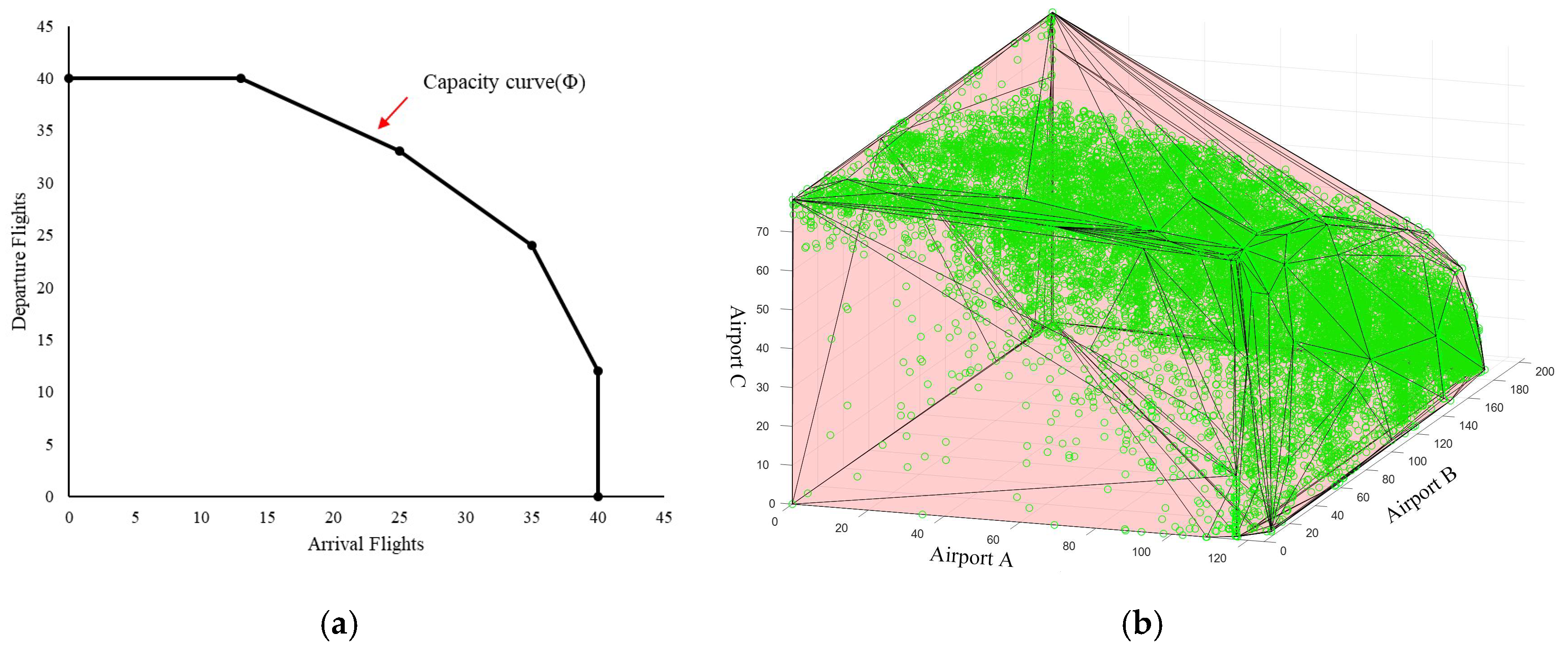
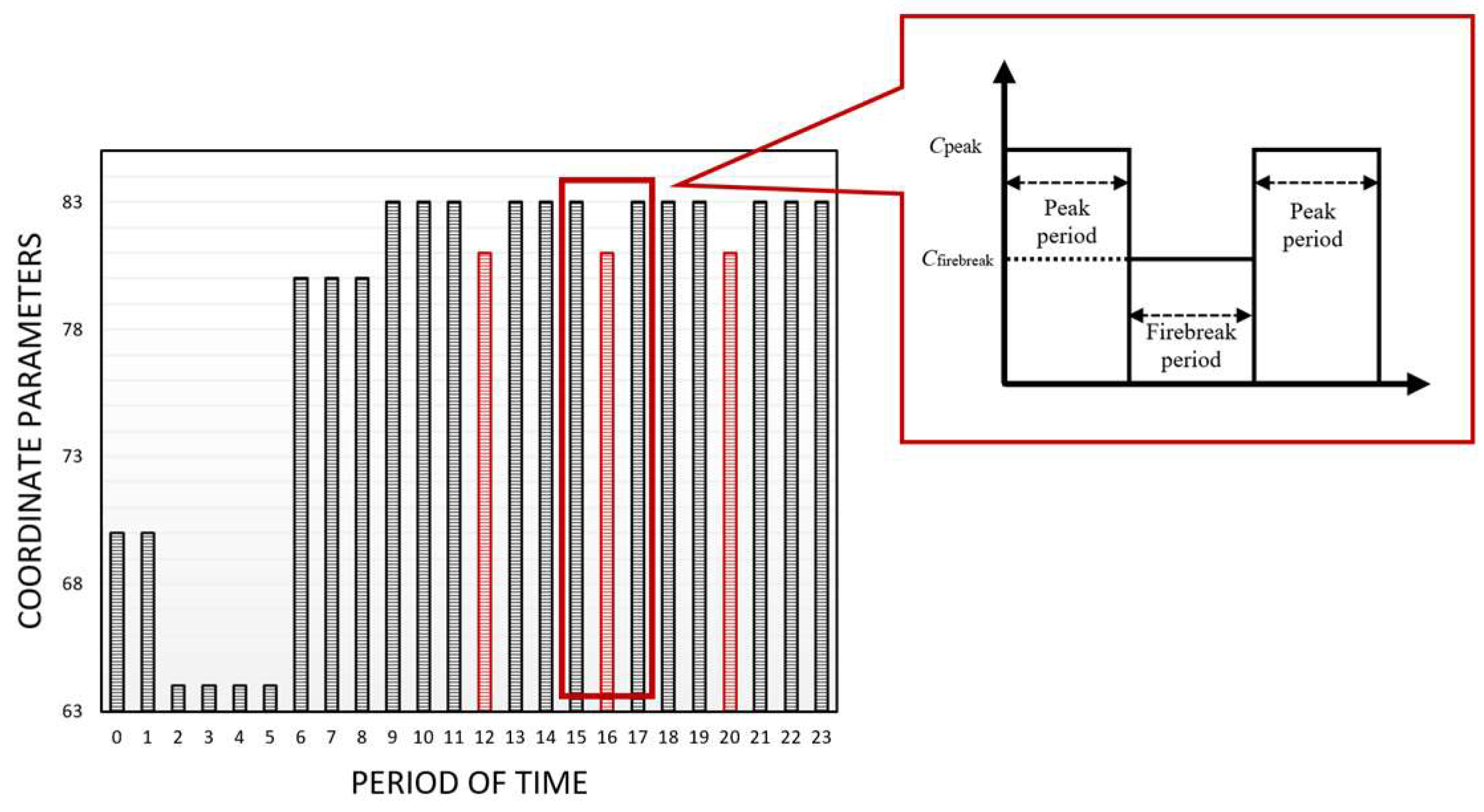

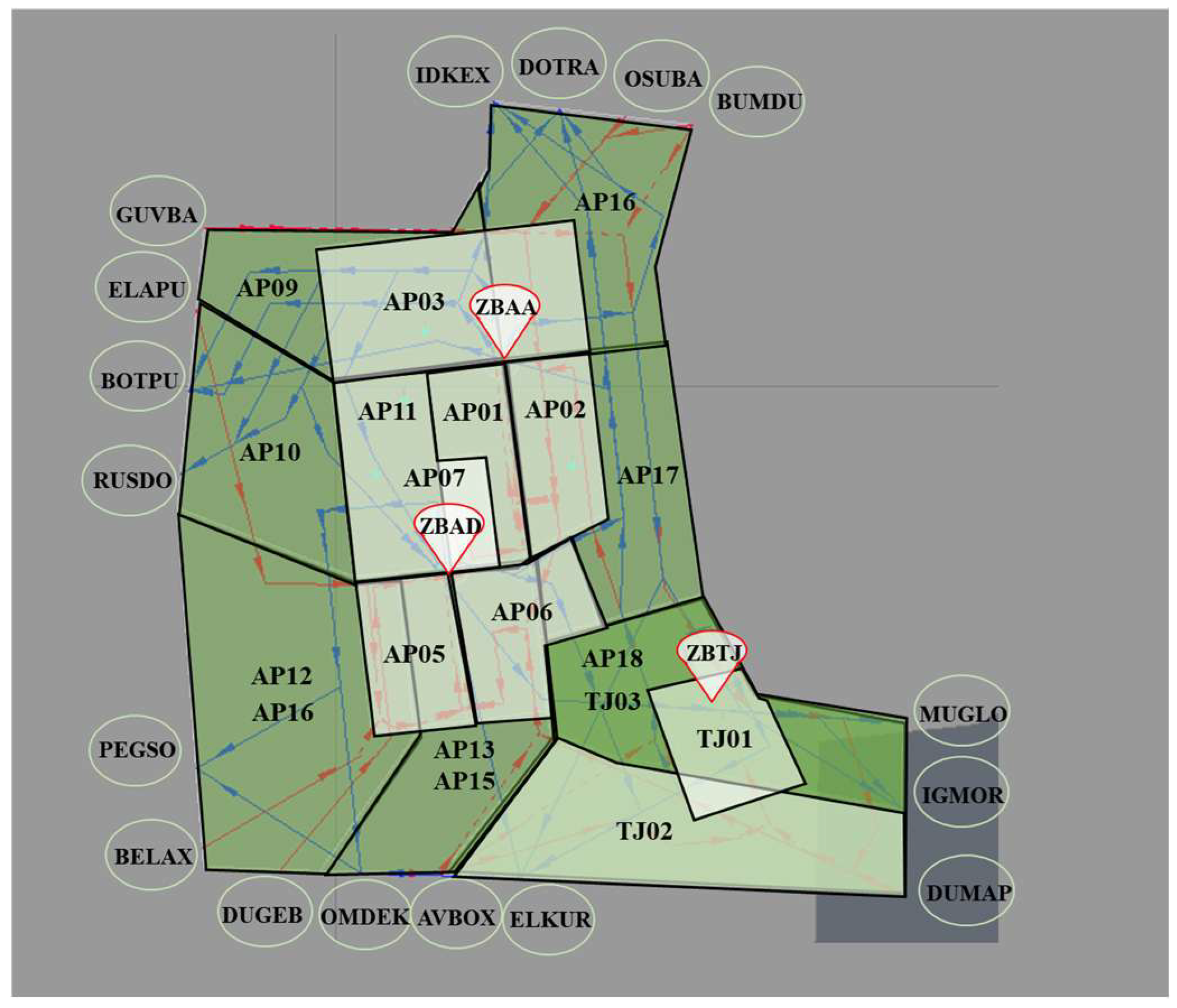
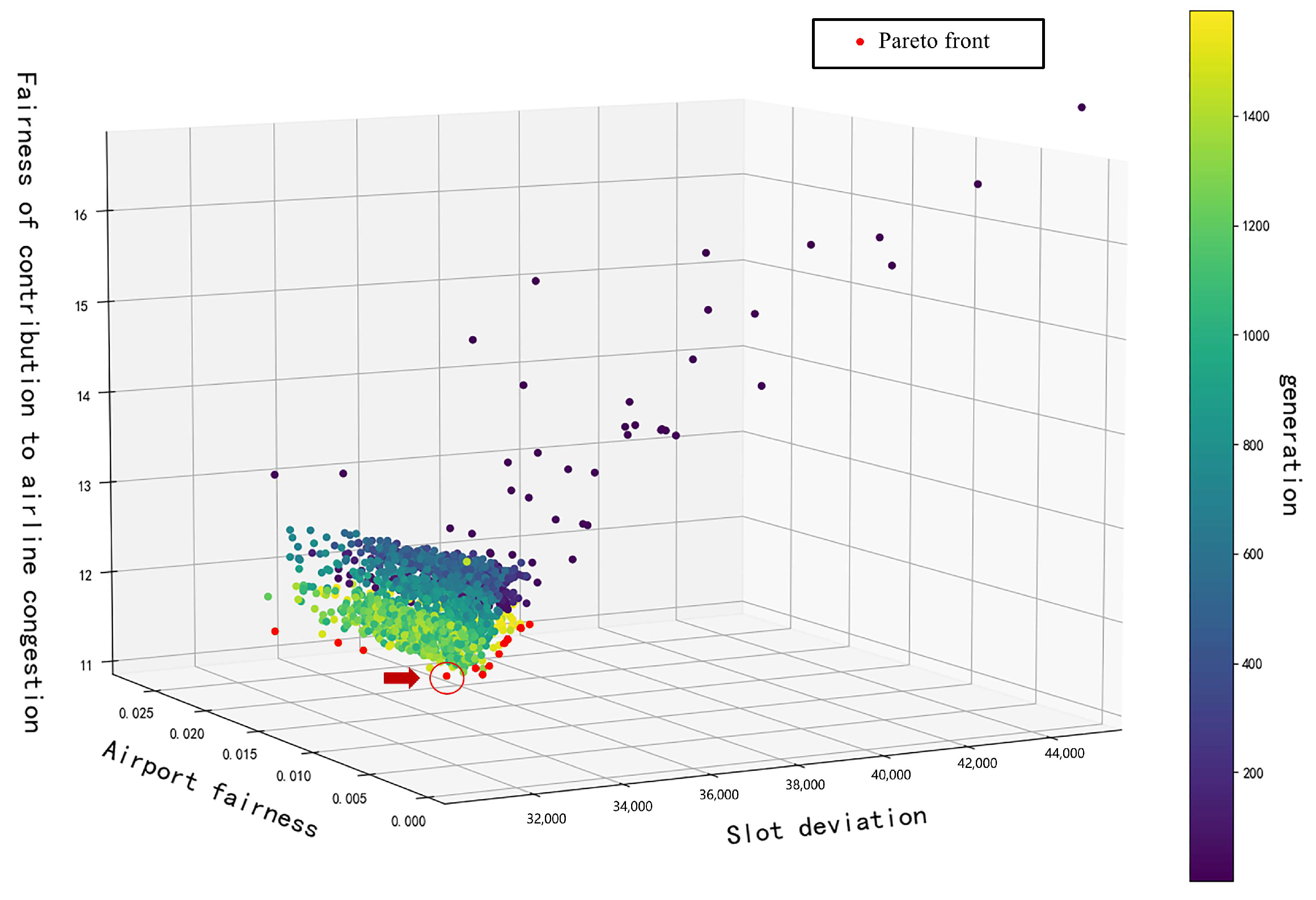
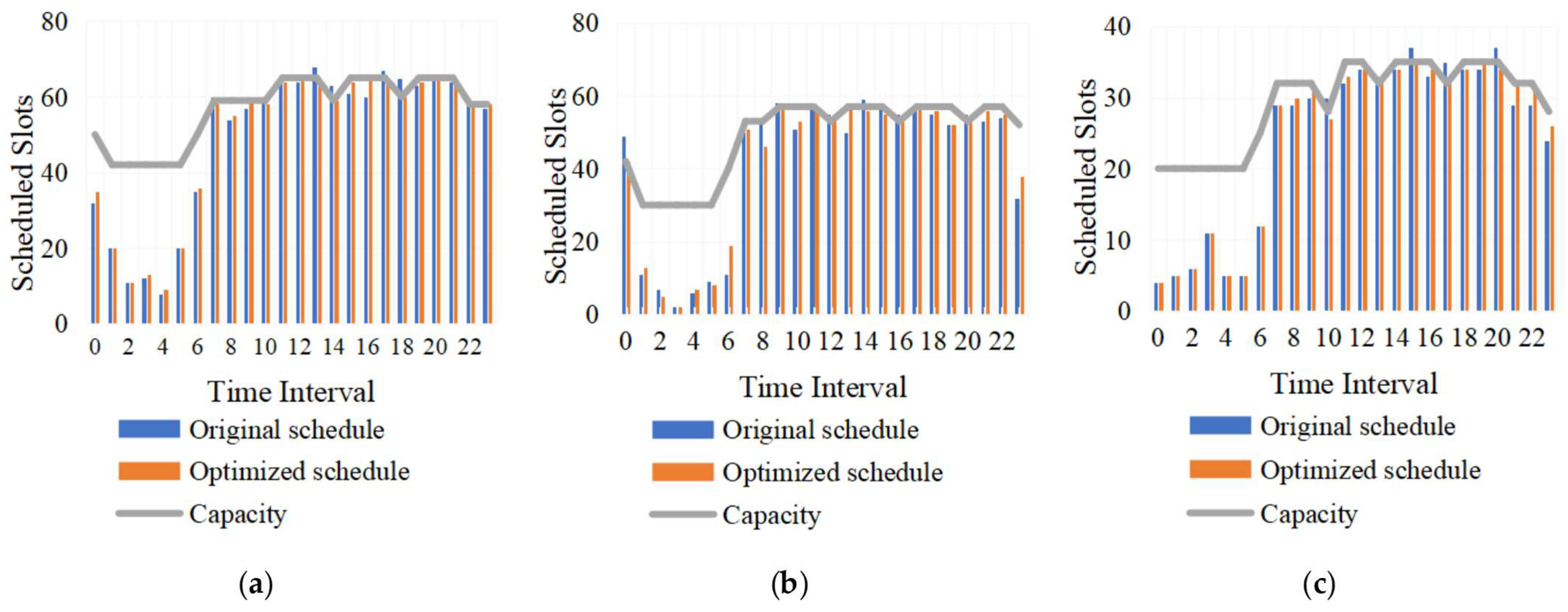




| Reference | Model Objectives | Constraints | ||||||||
|---|---|---|---|---|---|---|---|---|---|---|
| 24 h Coordination Parameters | Airport Capacity | Sector Capacity | Ground Resource | Multi-Airport Coupling Capacity | Corridor Port Capacity | Uncertain Ratio of the Capacity-Flow | Flight Transit Time | Acceptable Slot Deviation | ||
| [15] | Minimize total deviation | √ | √ | |||||||
| [16] | Minimize the weighted sum of total slot deviation and operation delay | √ | √ | |||||||
| [5] | Minimize total cost and number of slot deviations | √ | √ | √ | √ | |||||
| [7] | Minimize total delay, maximize the sum of average flight satisfaction across all airports, and minimize the deviation of average flight satisfaction across airports | √ | √ | √ | √ | |||||
| [11] | Minimize the weighted sum of the requested slots and slot deviations | √ | √ | √ | √ | |||||
| [17] | Minimize the total delay cost of flights in a multi-airport system | √ | √ | |||||||
| [12] | Airport slot deviation, total slot deviation, average delay, weighted sum of delay | √ | √ | √ | ||||||
| [13] | Minimize total delays | √ | √ | |||||||
| [14] | Minimize slot deviation, minimize the total number of flights to be scheduled, and scheduling fairness metrics | √ | √ | √ | ||||||
| [9] | Minimize total delay | √ | √ | √ | √ | |||||
| [18] | Minimize total delay time, minimize total delay cost, minimize total slot deviation, minimize total delay | √ | √ | √ | ||||||
| This Study | Minimize slot deviation and minimize both airport fairness and airline congestion contribution fairness | √ | √ | √ | √ | √ | √ | √ | √ | √ |
| Notation | Description |
|---|---|
| Sets | |
| M | Set of flights in the multi-airport system |
| U | Set of airports in the multi-airport system |
| I | Set of airline companies |
| Mu | Set of flights in airport u |
| Mu,a | Set of arrival flights in airport u,u U |
| Mu,d | Set of departure flights in airport u,u U |
| Set of transit flights in airport u,u U | |
| Mt | Set of flights in the time interval [1, t] |
| Set of flights passing fix k in the time interval [1, t] | |
| Set of flights passing fix k′ in the time interval [1, t] | |
| Set of flights of the s aircraft type in the time interval [1, t] | |
| Q | Set of aircraft types |
| S | Set of parking position types |
| T | Set of time slices |
| K | Set of corridors in airport terminal areas |
| H | Set of slots in the day, |
| Tm | Set of possible actual flight time slices for flight m |
| Parameters | |
| Number of total flights limit for airport u at time interval h,u U, h T | |
| Number of arrival flights limit for airport u at time interval h,u U, h T | |
| Number of departure flights limit for airport u at time interval h,u U, h T | |
| Airport group arrival capacity, departure capacity, and coupled capacity | |
| Number of total flights limit passing fix k at time window t,k K, t T | |
| tm | The requested slot for flight m |
| The actual slot for flight m | |
| Maximum acceptable deviation for departure flights | |
| Maximum acceptable deviation for arrival flights | |
| Minimum turnaround time for aircraft type q | |
| Scheduled turnaround time for aircraft type q | |
| Peak period capacity of airport u | |
| Peak period duration at airport u, in units of 5 min | |
| Firebreak period capacity of airport u | |
| Firebreak period duration at airport u, in units of 5 min | |
| Auxiliary variable to determine if a wave period occurs. If a wave occurs, is 1; otherwise, it is 0 | |
| Auxiliary variable to determine if a trough constraint needs to be imposed. When , the trough constraint is added; otherwise, 1 | |
| Decision variables | |
| Binary variables, where indicates flight m is assigned to arrive/depart no earlier than slot t and ; otherwise, t T, m M | |
| Indirect decision variables | |
| Equity indicators of congestion | |
| Number of flight deviations for airport u | |
| The time of arrival flights passing fix k in airport u,u U, k K | |
| The time of departure flights passing fix k in airport u,u U, k K | |
| AIRPORT | ZBAA | ZBAD | ZBTJ | |||||||||
|---|---|---|---|---|---|---|---|---|---|---|---|---|
| Absolute Time Deviation (Minutes) | SD a for SA b | SA b Probability | SD a for MA c | MA c Probability | SD a for SA | SA b Probability | SD a for MA c | MA c Probability | SD a for Single Airport | SA b Probability | SD a for MA c | MA c Probability |
| 0 | 112 | 10.08% | 72 | 6.48% | 83 | 8.60% | 74 | 7.67% | 47 | 8.80% | 54 | 10.11% |
| 5 | 257 | 23.13% | 185 | 16.65% | 197 | 20.41% | 171 | 17.72% | 104 | 19.48% | 100 | 18.73% |
| 10 | 176 | 15.84% | 169 | 15.21% | 185 | 19.17% | 162 | 16.79% | 85 | 15.92% | 79 | 14.79% |
| 15 | 130 | 11.70% | 140 | 12.60% | 131 | 13.58% | 130 | 13.47% | 65 | 12.17% | 75 | 14.04% |
| 20 | 436 | 39.240% | 545 | 49.05% | 369 | 41.04% | 428 | 44.35% | 233 | 43.63% | 226 | 42.32% |
| Total | 1111 | 1111 | 965 | 965 | 534 | 534 | ||||||
| Total deviation | 13,715 | 15,615 | 12,720 | 12,985 | 7005 | 6935 | ||||||
| Optimization Method | Slot Deviation | Airport Fairness | Airline Congestion Contribution Fairness |
|---|---|---|---|
| Multi-airport | 35,535 | 0.009 | 13.615 |
| Single airport | 33,440 | 0.018 | 18.044 |
| Algorithm | Delay Value/Second (Mean ± Standard Deviation) | ||||||||
|---|---|---|---|---|---|---|---|---|---|
| Average Delay | Average Approach Delays | Average Departure Delays | |||||||
| ZBAA | ZBAD | ZBTJ | ZBAA | ZBAD | ZBTJ | ZBAA | ZBAD | ZBTJ | |
| Scenario 1 | 283.1 ± 19.4 | 216.4 ± 15.4 | 403.1 ± 29.1 | 306.2 ± 19.1 | 172.3 ± 10.8 | 300.4 ± 18.9 | 446.2 ± 19.7 | 286.3 ± 14.8 | 551.4 ± 24.6 |
| Scenario 2 | 211.9 ± 21.1 | 201.4 ± 20.8 | 331.0 ± 36.2 | 174.6 ± 17.3 | 209.2 ± 18.1 | 379.1 ± 30.2 | 244.7 ± 22.6 | 200.8 ± 21.9 | 300.4 ± 41.4 |
| Scenario 3 | 191.3 ± 10.2 | 157.6 ± 11.2 | 218.4 ± 9.6 | 174.1 ± 7.9 | 111.0 ± 7.8 | 210.4 ± 8.9 | 210.1 ± 6.3 | 199.6 ± 11.2 | 221.8 ± 13.4 |
Disclaimer/Publisher’s Note: The statements, opinions and data contained in all publications are solely those of the individual author(s) and contributor(s) and not of MDPI and/or the editor(s). MDPI and/or the editor(s) disclaim responsibility for any injury to people or property resulting from any ideas, methods, instructions or products referred to in the content. |
© 2025 by the authors. Licensee MDPI, Basel, Switzerland. This article is an open access article distributed under the terms and conditions of the Creative Commons Attribution (CC BY) license (https://creativecommons.org/licenses/by/4.0/).
Share and Cite
Liu, S.; Wang, S.; Hu, M.; Yang, L. Slot Optimization Based on Coupled Airspace Capacity of Multi-Airport System. Appl. Sci. 2025, 15, 6759. https://doi.org/10.3390/app15126759
Liu S, Wang S, Hu M, Yang L. Slot Optimization Based on Coupled Airspace Capacity of Multi-Airport System. Applied Sciences. 2025; 15(12):6759. https://doi.org/10.3390/app15126759
Chicago/Turabian StyleLiu, Sichen, Shuce Wang, Minghua Hu, and Lei Yang. 2025. "Slot Optimization Based on Coupled Airspace Capacity of Multi-Airport System" Applied Sciences 15, no. 12: 6759. https://doi.org/10.3390/app15126759
APA StyleLiu, S., Wang, S., Hu, M., & Yang, L. (2025). Slot Optimization Based on Coupled Airspace Capacity of Multi-Airport System. Applied Sciences, 15(12), 6759. https://doi.org/10.3390/app15126759






